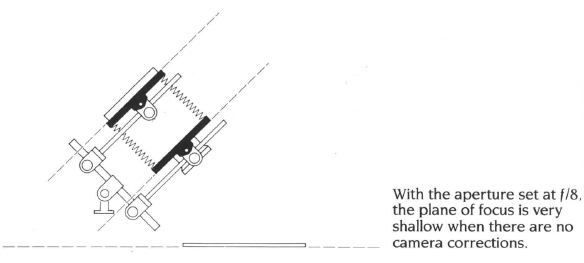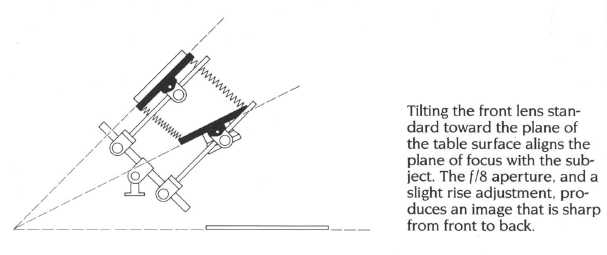
ZERO Movements

Front Standard Tilt
The only reason for
tilting and/or swinging the plane of the lens is to reposition the plane
of sharp focus within a scene—the shape of the subject does not change.
You can also control the plane of sharp focus by swinging or tilting the
camera back, but as we've seen, any angular movement of the back standard
also alters the shape of the subject.
Depending on where the lens pivots. the lens-to-film distance may or may
not be altered. If the lens pivots on its horizontal axis, the lens-to-film
distance doesn't change (only the angle of the lens' image changes). However,
if the lens pivots at its base. there will be a definite change.
Visualizing the concept of specific zones of focus is easy if you remember
that a lens can only focus sharply on one plane at a time. When a view
camera is set up with both front and rear standards in their normal or
zero positions, for example, the plane of sharp focus is a plane in space
that is exactly parallel to them (just where in space that plane falls
depends on where you've focused the lens). Now, if you tilt or swing the
lens that plane of sharp focus moves. Tilt the lens forward and the plane
of sharp focus also tilts forward (to an even greater extent than the
tilt of the lens). Swing the lens left or right, and there is a similar
swing in the plane of sharp focus. Since few subjects are perfectly flat
and perpendicular to the lens axis (other than paintings or walls) this
ability to change the angle of the plane of focus can be a very useful
control for the view camera user.
Interestingly, if
you stand facing the side of the camera and draw an imaginary line through
each of the planes of the subject, lens. and film. you will find that
these three planes meet along a common line. This relationship of the
convergence of the three planes is known as the Scheimpflug rule—named
after Theodor Scheimpflug, the Austrian surveyor who first discovered
the principle in 1894. Scheimpflug observed that when these three planes
met on a common line, the entire image was sharp from near to far, even
at full aperture. Keeping this principle in mind can be very useful in
finding the proper amount of lens and back tilt needed to give maximum
sharpness for a given scene.
In one sense. a photograph made using the tilts and swings necessary to
satisfy the Scheimpflug rule seems to reveal great depth of field. In
the second image of the card table, for example. the plane of sharp focus
extends from the near edge of the table to the far side. But don't confuse
a long plane of sharp focus with great depth of field. Although the image
is sharp from near to far the depth of field is not equally wide throughout
its placement in the scene. Technically, depth of field increases by the
square of the subject distance. In other words. depth of field increases
dramatically with increasing distance from the lens. and as you can see
in the accompanying diagram. it actually forms a funnel-shaped pattern
expanding outward from the camera_
Expose AT LEAST 4 sheets of film and develop them before class on Tuesday
1) Find subjects with strong flat horizontal components that you can look down on-
2) Place the camera to frame the subject on a flat plane (table) (landscape)
3) Tilt the camera to compose the subject with no movements, focus on foreground object
4) Use your digital camera to shoot your subject from the same camera position, zoom to match the same framing.
5) check the digital image to see if the lighting and subject matter looks the way you want.
6) Meter the subject, use the Quick Disc to determine if you need to compensate for bellows extension. -expose film.
7) Use the front standard in a tilt to sharpen the plane of focus - (you might have to use rise-fall to recompose)
8) Repeat this with a vertical subject that extends away from the camera (like a wall)
Use the Front Standard SWING for the same effect as the tilt.Develop and scan your film before class- upload your digital location shots for comparison.